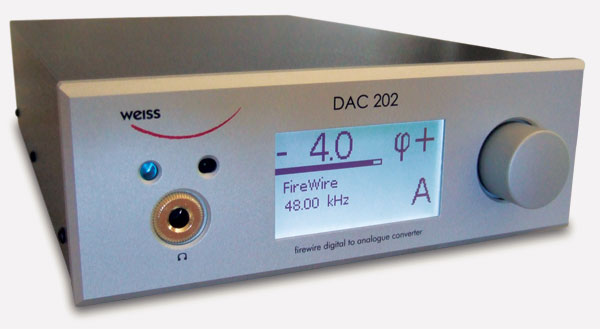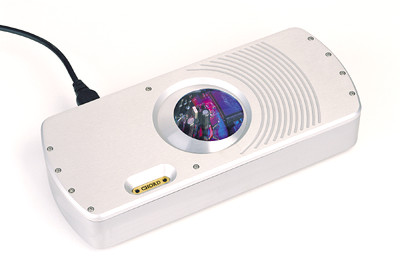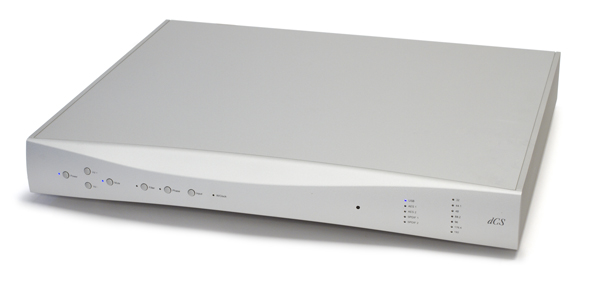Daniel Weiss began his career as an engineer at Studer-Revox, where he specialized in the design of sampling frequency converters. In 1985, he founded Weiss Engineering Ltd. His company is probably more well-known in professional circles than in home audio, with clients like Sony, BMG, and Abbey Road, to name a few. Weiss first entered the high-end market in 2001. The technology in this DAC is a result of twenty-five years of experience in the professional field.
The Weiss DAC202 was introduced in 2009 and uses two-stage phase locked loop (PLL) circuitry to address high and low frequency jitter. Most DACs, according to the firm at the time, only suppress higher frequencies, but this one also suppresses low-frequency jitter, which, according to Weiss, might be more damaging to the overall sound than high-frequency jitter. The DAC202’s clock regulates the computer’s audio clocking because it employs an asynchronous FireWire link.
The unit is small (19cmx30cmx7cm) and bears no resemblance to Weiss’s Pro Audio beginnings. The front panel is made of solid aluminium and features an LCD panel in the center that displays phase, input, sampling rate, and filter type. You may access a full menu by depressing the rotary knob, which includes output level gain and other information about the incoming signal. You can do a bit transparency check by playing a file from the included CD and seeing whether any bits are missing! After you’ve completed the exam, you’ll either be awarded with the bitrate or suffer the humiliation of seeing the word “fail” appear on the screen. This is a helpful function that guarantees the DAC has processed all of the data in the test file. In the past, such a test would have necessitated the use of a plethora of expensive equipment. S/PDIF, Toslink, and AES/EBU inputs, as well as RCA and balanced outputs, are located on the back panel.
A gold-plated headphone jack with its own output stage is also included on the Weiss. The output volume can be adjusted either manually with the knob or digitally with the remote handset. Another important option is to adapt the output to the sensitivity of your headphones by pushing the same control, showing the general menu, and selecting the appropriate output voltage range. Similarly, you can select the output voltage range that best suits your power amplifier, eliminating the need for a preamp in the chain. There’s a decent remote control with input selectors, digitally and constantly changing volume (the rotary knob only accomplishes this in discrete stages), phase, filter, and mute buttons, as well as phase, filter, and mute buttons.
There’s an amazing period in Mozart’s Jupiter Symphony’s Coda, where, as a final act of symphonic orgiastic bravura, Mozart seeks to push counterpoint to its traditional extremes by combining five themes at once. Because the texture is complex and only the best can make sense of the chaos, this region represents a watershed for many systems. The Weiss DAC202 is endowed with a remarkable sense of clarity. This recording transports you to the center of the concert, surrounded by air and space and a true holographic impression of the orchestra. The flutes are breathy, the timpani’s firm sticks sting with clarity, and the string section exudes personality.
With a confident unflappability, the Weiss takes everything in stride. Clean, rhythmic, and perfectly timed bass is among the best I’ve heard from a DAC of this era. When listening to my own recording of the Allegri String Quartet performing Beethoven’s Quartet Op 59 No2, I’ve discovered that quick volume changes when listening to Beethoven’s Sforzandi (accents) from this close-miked recording can cause distortion on some DACs. The Weiss eliminated all traces of this, leaving a spotlessly clean image of the four instruments that matched my memory of the quartet’s sound perfectly. There is very little blurring or embellishment, and I can clearly distinguish the audible distinctions between the 1st Violin’s Cremonese Amati and my Brescian Maggini violin. Beethoven’s rapid-fire cellular units are superbly etched out in space in this movement, and the sense of ‘danger’ of these parts comes to life.
This recording hasn’t been altered in any way. I’m drawn to recordings that haven’t had much mastering done to them. Why does fifties jazz sound so good on vinyl, and Apple’s release of the Beatles’ rehearsal tracks a few years ago seem more musically revealing than the cheesy sixties and seventies concoctions that were presented to the world? If all of this sounds a little Jamie Oliver-ish, it’s because this piece of equipment’s biggest skill is that it doesn’t make the music feel processed. It takes the best from the professional world and expertly navigates the big divide.
The Weiss headphone stage was clearly in a different league when listening to the last movement of Mozart’s 39th Symphony. The Weiss’s double bass notes started and stopped with better precision, and the bass was tighter. On the Weiss, violins sounded more cohesive and lifelike, with a greater sense of depth in the soundstage. The Minnesota Orchestra’s performance of Rachmaninoff’s Symphonic Dances opens with a thundering bass line, which the Weiss was excellent at deciphering. With a wide range of tonal palettes at its disposal, instruments were wonderfully engraved in space. The headphone stage isn’t an afterthought – I’ve never heard Sennheiser HD650s sound better.
The Weiss DAC202 is an intriguing, quirky, and accomplished product that delivers a remarkably clean and controlled sound with high levels of clarity and insight into the musical performance. It’s a reference in the proper meaning of the word, in that it’ll tell you what’s wrong with a recording, but with the right source material, it soars to new heights. One of the greatest high-end DACs available at the time. RT







